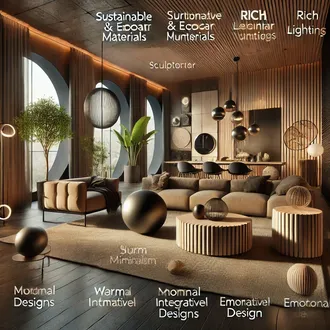Transcription Principles of decoration (1)
In this presentation we will learn about other principles of decoration: harmony, variety, rhythm and emphasis.
Harmony
Harmony, as well as balance, aims to achieve unity, through balance is achieved by the careful placement of each of the objects, while the principle of harmony is to achieve the unity of a set through the repetition of one of the following elements: shape, color, material, texture, detail, function, etc..
The treatment of harmony in decoration must be careful; a space that includes too many objects with similar treatments (same shape, color, texture, etc.) can highlight the unity but can be monotonous, uninteresting. On the other hand, if you try to avoid monotony by employing too many objects with different treatments, the space tends to look chaotic.
Variety
We already knew that the principles of balance and harmony are most effective when different elements are included to enhance the interest of the whole. The principle of variety consists of introducing different elements or objects in a grouping, to break the monotony that can be caused by perfectly balanced and harmonious environments.
The concept of visual unity of groupings of different objects can be achieved by forming groups of objects close to each other and relatively separated from the rest; the unity of these can be reinforced if the set is placed within or around a well-defined line or area (different floor color, carpets, etc.); or grouping them in front of an element that serves as a common background (a fireplace, a wall with a striking color or texture, etc.).
Rhythm
The principle of rhythm in interior decoration consists of the periodic repetition of elements or objects in space in order to create an attractive route for the movement of the eye and the thoughts of the observer, allowing him to enjoy each of the elements of the composition and the whole space in general.
If we want to obtain a more recognizable visual rhythm we should employ recurring elements with characteristics (colors, textures or details) that contrast with the general environment, or plan repetitions that appear in a linear fashion.
If, on the other hand, we want to obtain a more subtle visual rhythm, we should use non-linear sequences of shapes, textures and colors that are less obvious.
Often some interior architectural elements (such as columns, stairs, railings, etc.) help to achieve the visual rhythm of a room.
Emphasis
The principle of emphasis is to endow (one or several elements of a composition) with exceptional qualities (unique shape, larger size, different textures, etc.) to make it be recognized as a more important (dominant) element than the rest of the objects that accompany it.
The emphasis, like the other principles of decoration should be moderate; while the monotony caused by the absence of dominant elements makes the room boring; the exaggerated use of dominant elements may seem chaotic and disorderly. The decorator will have complied with this principle, when in the composition of the room a coherent presence of dominant and subordinate elements is perceived.
To achieve a greater visual emphasis on an element, in addition to providing it with exceptional qualities (size, shape, etc.), they should be placed in strategic locations such as: in the center of a radial balance, at the end of an axial balance or where there is a special lighting.
principles 1




